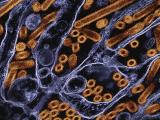Nov 21, 2006 (CIDRAP News) – Researchers recently reported identifying two mutations in the H5N1 avian influenza virus that seem to improve its ability to attach to human cells, a finding that may help scientists spot H5N1 strains capable of infecting humans.
An international team of scientists determined that in the laboratory, two mutations in the hemagglutinin (HA) molecule of H5N1 viruses gave them the ability to recognize and bind to human-type cell receptors, according to the report in the Nov 16 issue of Nature.
"The amino acid changes that we identify might serve as molecular markers for assessing the pandemic potential of H5N1 field isolates," says the report by Shinya Yamada of the University of Tokyo and other scientists from Japan, Vietnam, Indonesia, the United Kingdom, and the United States.
H5N1 viruses have killed millions of birds since late 2003 but still infect humans relatively rarely, having caused 258 illness cases with 153 deaths so far. Previous studies have shown that avian and human influenza A viruses recognize different host-cell receptors. Avian flu viruses prefer a cell receptor molecule consisting of sialic acid with an alpha2,3 linkage to galactose (called SA-alpha2,3Gal), whereas human flu viruses prefer receptors consisting of sialic acid with an alpha2,6 linkage to galactose (called SA-alpha2,6Gal).
Because of this, a change in preference from SA-alpha2,3Gal to SA-alpha2,6Gal is believed to be one of the steps that could enable the H5N1 virus to readily infect humans and possibly lead to a pandemic.
Yamada and colleagues set out to determine which mutations in the HA protein enable it to recognize human type receptors. They used clones of three H5N1 isolates from Vietnam, and they also synthesized the HAs of eight other H5N1 viruses collected from humans in Thailand, Vietnam, and Cambodia by using data from a public sequence database. The team created hybrid viruses by combining these HAs with the neuraminidase from a 2004 Vietnam H5N1 isolate and six genes from a laboratory strain of H1N1 virus.
The researchers then assessed the binding of these viruses to artificial surfaces made of sialylglycopolymers that featured either the avian or the human type of receptor. They found that none of the five avian strains attached to the human type receptors, whereas 3 of 21 viruses representing human isolates bound to both the avian and human receptors.
In comparing the HAs of these three viruses with an avian type HA, the scientists found that two of them differed from the avian type HA at two amino acid positions each (a total of four mutations, at positions 192, 223, 139, and 182). To test the effects of these mutations, the team introduced the mutations into the virus with the avian form of HA. They found that introducing one of a pair of mutations improved the virus's ability to bind to human type receptors, and introducing both mutations increased that ability further.
The team also analyzed the crystal structure of one of the viruses and concluded that the locations of two of the mutations, at positions 182 and 192, suggest that an effect on receptor binding is plausible.
Further, the scientists report that these same two changes (at 182 and 192) were present in H5N1 viruses isolated from two people in Azerbaijan and one person in Iraq, but not in any of more than 600 avian isolates that have been examined.
The authors conclude that amino acid changes at positions 182 and 192 in the HA molecule "independently convert the HAs of H5N1 viruses known to recognize the avian receptor to ones that recognize the human receptor."
However, the mutations the scientists identified have not yet equipped H5N1 to spread easily from person to person, and the authors acknowledge that mutations in proteins other than HA may be necessary before that can happen. But the mutations they identified "might provide useful molecular markers in assessments of H5N1 field isolates for their capacity to replicate in humans—an essential indicator of pandemic potential," they write.
The senior author of the article isYoshihiro Kawaoka of the University of Wisconsin and the University of Tokyo. In a University of Wisconsin news release, he said it is not known how many mutations will be required for the virus to fully adapt to humans. But if scientists continue to monitor the virus in humans, they may be able to trace a "mutation trajectory" that will help them predict when the virus will reach that point, he said.
Hamada S, Suzuki Y, Suzuki T, et al. Haemagglutinin mutations responsible for the binding of H5N1 influenza A virus to human-type receptors. Nature 2006 Nov 16;444(7117):378-82 [Abstract]
See also:
University of Wisconsin news release (Nov 15)
http://www.news.wisc.edu/13198.html




















